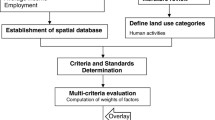Abstract
Zoning is an important tool used in the management of protected areas and wetlands. It has been developed to apply conservation objectives at different levels of management where conflicting uses can be taking place. GIS is increasingly used to solve land allocation problem with techniques based on zoning, varying from simple overlays to complex multi-criteria evaluation techniques (MCE). This study presents a new approach to the development of zoning plans for Ramsar sites that exhibit major seasonal variations in conservation value and human use and threats. It employs a well-defined GIS-based MCE technique which involves both expert judgment and a set of criteria based on ecological and potential threats. A GIS model using the additive approach in MCE was developed to evaluate Sabkhat Al-Jabboul the only Ramsar site in Syria. The model was applied separately for the spring and winter to accommodate seasonal changes in the intensity and spatial distribution of conservation areas and threats across the site. Separate zoning plans were developed for each of the two main seasons. The zoning plan of the spring season, which is the birds breeding season, included three management zones; the special conservation zone, the conservation buffer zone, and the wise use zone. The winter zoning plan, where the bird feeding activity was the major activity includes two zones: a special conservation zone and a wise use zone. Thus, in cases like Sabkhat Al-Jabboul, where the wetlands are subject to significant seasonal variations, in their ecology and human utilization, it is recommended that flexible seasonal zoning plans are developed to assist in the organization of permitted activities, and to reduce the potential human impacts throughout the year.





Similar content being viewed by others
References
Abdul Salam A (2002) Geography of Syria [in Arabic]. United Press, Damascus [in Arabic]
Boulad N (2014) The use of multi-criteria evaluation and expert knowledge in developing protected area zoning plans in Jordan. Jordan J Nat Hist 1:165–180
Dahman M (2002) Description of the environmental state of Jabboul Lake [in Arabic]. Directorate of Agriculture, Aleppo
Day JC (2002) Zoning—lessons from the Great Barrier Reef marine park. Ocean Coast Manag 45(2):139–156
Edward J, Rykiel JR (1996) Testing ecological models: the meaning of validation. Ecol Model 90:229–244
Geneletti D, Van Duren I (2008) Protected area zoning for conservation and use: a combination of spatial multi criteria and multi objective evaluation. Landsc Urban Plan 85(2):97–110
Hamidan N, El-Moghrabi L (2008) Water birds Survey Report of Sabkhat Al-Jabboul Aleppo / Syria. Privately Published, The Royal Society for the Conservation of Nature, Amman
Jiang H, Eastman R (2000) Application of fuzzy measures in multi-criteria evaluation in GIS. Int J Geogr Inf Sci 14(2):173–184
Kangas J, Store R, Leskinen P, MehtaÈtalo L (2000) Improving the quality of landscape ecological forest planning by utilising advanced decision-support tools. For Ecol Manag 132(2):157–171
McNeely JA (1997) New trends in managing and protecting biodiversity. Ecodecision 23:20–23
Nhuan M, Ngoc N, Huong N, Hue N, Tue N, Ngoc P (2009) Assessment of Vietnam coastal wetland vulnerability for sustainable use (Case study in Xuanthuy Ramsar Site, Vietnam). J Wetl Ecol 2:1–16
Ramsar Convention on Wetlands (2002) New guidelines for management planning for Ramsar sites and other wetlands. In: 8th Meeting of the conference of the contracting parties to the convention on wetlands (Ramsar, Iran, 1971) Valencia, Spain, 18–26 November 2002
Sabatini, MC (2003) Zoning of protected areas: conceptual framework and quantitative methodological development for execution [in Spanish]. MSc Thesis, Universidad Nacional del Sur, Argentina
Serra G, Murdoch D, Turkelboom F, Travert F, Mujawer Y, Scott DA (2006) Sabkhat al-Jabbul, a threatened Ramsar wetland in Syria. Sandgrouse 28(2):127–141
Store R, Kangas J (2001) Integrating spatial multi criteria and expert knowledge for GIS based habitat suitability modeling. Landsc Urban Plan 55:79–93
The Royal Society for the Conservation of Nature, Jordan (RSCN) (2013) Management plan of Azraq Wetland Reserve. Privately Published, Amman
Villa F, Tunesi L, Agardy T (2002) Zoning marine protected areas through spatial multiple-criteria analysis: the case of Asinara Island National Marine Reserve of Italy. Conserv Biol 16(2):515–526
Walther P (1986) The meaning of zoning in the management of natural resources lands. J Environ Manag 22:331–343
Acknowledgements
This work was performed with the support of Mr. Zaher Abo Baker, the Jabboul Project manager at the time of the survey, who facilitated all the administrative and logistical support. We acknowledge the support and guidance of the whole survey team including Laith Al-Moghrabi, Yaseen Mujawer, Essa Al-Ibraheem, Ahmad Al-Mawwas, and Khalid, Sami, Ma’rouf. Thanks also to Nasr Al-Tamimi, the regional project manager, who facilitated the team travelling from Amman to Aleppo. The Royal Society for the Conservation of Nature (RSCN), the Syrian Society for the Conservation of Wildlife (SSCW), and the Swiss Agency for Development and Cooperation (SDC) are all acknowledged for their support and funding. Finally, the authors would like to thank Dr Chris Goldspink for his valuable comments on the manuscripts.
Author information
Authors and Affiliations
Corresponding author
Rights and permissions
About this article
Cite this article
Boulad, N., Hamidan, N. The use of a GIS-based multi-criteria evaluation technique for the development of a zoning plan for a seasonally variable Ramsar wetland site in Syria: Sabkhat Al-Jabboul. Wetlands Ecol Manage 26, 253–264 (2018). https://doi.org/10.1007/s11273-017-9568-5
Received:
Accepted:
Published:
Issue Date:
DOI: https://doi.org/10.1007/s11273-017-9568-5




